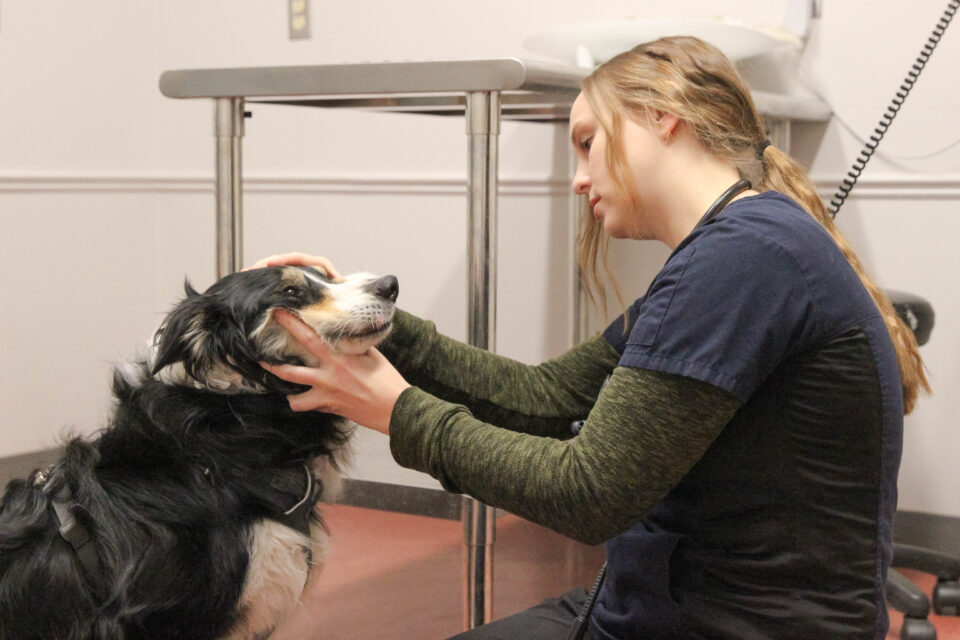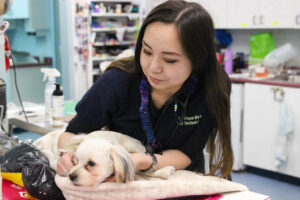Early Disease Detection

Early Disease Detection is a series of tests that add up to make a complete internal physical exam. An internal physical exam involves collecting blood and urine and taking radiographs (x-rays) to determine the state of your pet’s internal organs. Conducting these tests yearly in senior pets can help us discover disease processes in the very earliest stages. Early detection can allow us to treat or even cure diseases.
Who needs it?
Early Disease Detection is recommended for every healthy appearing senior pet. Cats and small breed dogs are considered seniors at 10 years of age. Medium and large breed dogs are considered seniors at 8 years of age, while giant breeds are seniors at 6 years. Yearly testing in these pets can alert us to the beginning stages of various diseases.
What does it involve?
The internal physical exam takes place in 3 parts: bloodwork, urinalysis and radiographs.
Bloodwork
We take a small sample of your pet’s blood and assess a variety of factors, including: red blood cell count, white blood cell type and count, platelet count, and 12 blood chemistry values. Blood chemistries provide valuable information about a variety of internal structures such as the liver, kidneys, pancreas, intestines and bones. We can even look for markers that could be linked to hormonal disorders and early cancer.
Urine
For the second step of the internal physical exam, you bring us a sample of your pet’s urine. We examine the urine for its level of concentration and pH, as well as various chemicals that maybe present. An example is glucose, which can be found in the urine in cases of diabetes.
Urine specific gravity is a measure of how concentrated the urine is. An important function of the kidney is the excretion of toxins in the body, typically using as little body water as possible. As kidney disease develops, kidneys lose the ability to concentrate urine and the pet must drink more water to keep up with the amount of water used by the kidneys. During wellness screening we measure the urine specific gravity to indicate if the kidneys are concentrating urine well.
We also examine the urine for the presence of protein. As kidneys filter toxins from the blood, they are designed to keep larger molecules like useful proteins from being lost in the urine. If protein is present in the urine it may signal the onset of kidney disease.
Radiographs
For the final step of the exam we take 5 radiographs of your pet. This includes 3 views of the chest and 2 views of the abdomen. These radiographs provide us with valuable information regarding the physical structure of the lungs, heart, liver, spleen, gastrointestinal tract, kidneys, bladder, and the bones of the spine.
Early Disease Detection Can Help Diagnose:
- Addison’s Disease
- Anemia
- Arthritis
- Bladder Stones
- Cardiomyopathy (disease of the heart muscle)
- Chronic Renal (kidney) Disease
- Congestive Heart Failure
- Cushing’s Disease
- Diabetes
- Electrolyte Imbalances
- Foreign Body Ingestion
- Hernias
- Heartworm Infection
- Hypoalbuminemia (low protein in the blood)
- Intervertebral Disc Disease
- Liver Disease
- Lung Disease
- Lungworm Infection
- Masses/Tumours
- Neoplasia (cancer)
- Organ Enlargement
- Pancreatitis
- Prostatitis (infection in the prostate)
- Pyometra (infection in the uterus)
- Thyroid Disease
- Urinary Tract Infection
What If Early Disease Detection Doesn’t Find Anything Wrong?
That’s great news! Determining that your pet is as healthy on the inside as she appears on the outside brings confidence and peace of mind. Also, the test results will be saved and compared each year when we do Early Disease Detection again. This allows us to track very small changes that can be the start of larger disease processes. Annual external and internal physical exams combine to keep your pet healthier, happier, and sharing your life longer.

